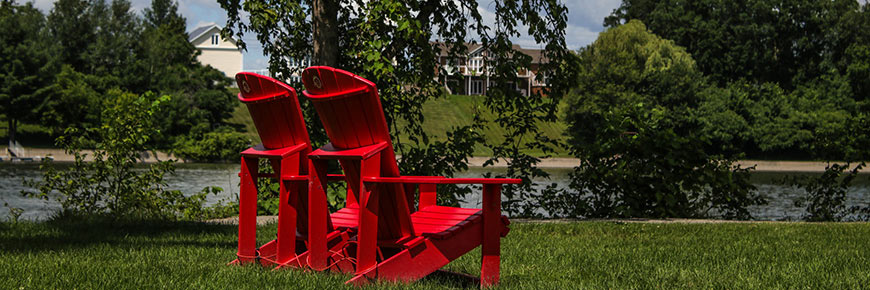
Nature and science
Saint-Ours Canal National Historic Site
The Saint-Ours heritage canal runs along the eastern bank of the Richelieu River, about 23 km upstream from the town of Sorel.
Climate
The Saint-Ours Canal is located in the Montréal climatic region, which covers Saint-Pierre Lake, the Richelieu Valley and the top of Lake Champlain. This region has one of the mildest climates in Quebec, with an average annual temperature of 6° C, and an average July temperature of 13° C. These temperatures are both higher than elsewhere in Quebec.
This region also enjoys the longest frost-free period, the longest day-length period and the highest number of growing degree-days in Quebec. The prevailing winds are from the southwest. The highest wind speeds are from the west and northwest.
Geology
This site rests on sedementary rocks from the Ordovician period which are about 400 million years old.
The bedrock of this area consists of clay schists and sandstone of the Queenston formation (locally known as the Becancour River formation) at least 610 m deep. Clay schists are sedimentary rocks of mechanical origin made from disintegrated fragments of other rocks. Sandstone is formed from accumulated fragments of quartz and is always formed by river deposits.
Historically, the formation of rocks in this region was a result of its submersion (near the end of the Ordovician era), which left marine sediments. Raised by tectonic forces, the region was eroded from the end of the Ordovician era until the end of the Tertiary era. After having been covered with a thick layer of ice during the Quartenary era, the St. Lawrence Lowlands were flooded by the Champlain Sea. This flooding was brought on by a lowering of the stratum, caused by the weight of glaciers. After having deposited clays and sands, the sea receded (following further shifts in the platform) and left the region in its current state.
Geomorphology
This sector is smooth terrain covered with a clay deposit that is 50 m deep in some places. Altitude barely exceeds 15 m above sea level. These lowlands were formerly part of a St. Lawrence alluvial plain larger than today. During a relatively recent geological era, glaciation modified the landform, which was subsequently masked by the deposit of post-glacial sediments from the Champlain Sea.
The Saint-Ours Canal site is also located in a zone of recent silty clay alluvium, superposed on the Champlain Sea deposits.
Pedology
The Champlain Sea deposits and alluvium form the substrate and bedrock that resulted in the area's present-day soils. These show the combined effects of climate, vegetation, micro-organisms and drainage on the top few metres of the original underlying deposits. Certain soil groups have been differentiated based on dominating local factors.
The soil surface of this site has been extensively disturbed. As a result, it is virtually impossible to define its original profile. These reworked soils are characterized by a silty clay structure.
Hydrology
The Saint-Ours Canal is located in the catchment area of the Richelieu River, the largest of the St. Lawrence tributaries south of the 50th parallel.
The present-day dam adjacent to Darvard Island was built in 1969 to regulate the course of the Richelieu River over a 45-km stretch between the municipalities of Saint-Ours and Chambly.
The Saint-Ours Canal has only one lock. The resulting stretch of water is 103 metres long by 14 metres wide. Maximum depth is 3.5 metres. The drop between the two bodies of water is 1.5 metres.
Flora
J.S. Rowe (1972) defines this sector as being part of the Upper St. Lawrence forest area. We can therefore expect the natural forest cover of this site to be dominated by the Sugar Maple ( Acer saccharum ), Red Maple ( Acer rubrum ), American Beech ( Fagus grandifolia ), American Ash ( Fraxinus americana ), along with the Red Oak ( Quercus rubra ), Burr Oak ( Quercus macrocarpa ), Red Ash ( Fraxinus pennsylvanica ) and Hickory ( Carya sp .).
Although most of these species are indeed found on the site, the tree cover is clearly dominated by pioneer or transitional species. Red Pine ( Pinus resinosa ) clearly dominates the tree stratum. Together with the White Pine ( Pinus strobus ) and Basswood ( Tilia americana ), it is found on the elevated and well-drained sections of Darvard Island. The American Ash is the site's second most common species. It is found in damper areas, along the Richelieu River, along with the Red Elm ( Ulmus rubra ) and the Saskatoon Berry ( Amelanchier sp ). Also found on the site are pioneer species that include the Trembling Aspen ( Populus tremuloides ), Large-Toothed Aspen ( Populus grandidentata ), Cottonwood ( Populus deltoides ) and Paper Birch ( Betula papyrifera ).
Shrubs include the Western Dogwood ( Cornus stolonifera ), Hawthorn ( Crategus sp .), Black Cherry ( Prunus serotina ), Arrowwood ( Viburnum sp. ) and Large-leaved Meadowsweet ( Spirea latifolia ). These shrub species are particularly found on slopes.
Fauna
With its many visitors, this site is not an ideal habitat for fauna, except for species highly tolerant of man's presence. However, because it is on a main migration route, many different birds can be seen here. The Saint-Ours dam constituted a major obstacle for the free circulation of fish in the Richelieu River. Since the opening of the Vianney-Legendre Fish Ladder many species of fish can now transit freely upstream. However, the red squirrel (Tamiasciurus hudsonicus ) can often be spotted. In the areas immediately surrounding the canal, the groundhog ( Marmonta monax ), meadow vole ( Microtus pennsylvanicus ) and striped skunk ( Mephitis mephitis ) are frequently seen.
- Date modified :